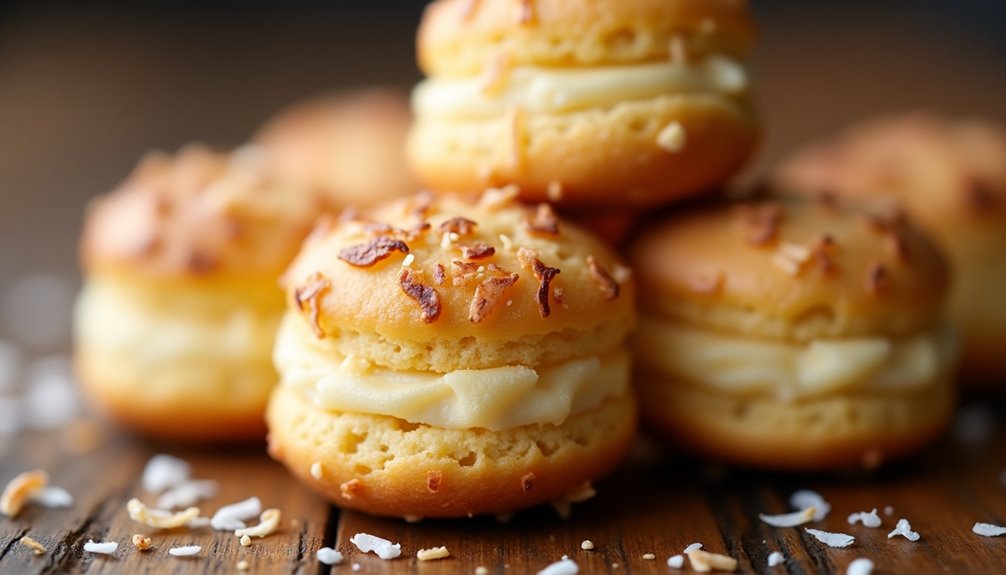Coconut macaroons are a chewy, sweet delight that brings a taste of tradition and joy to every bite. Originating from Mediterranean roots, they became a staple in Jewish cuisine, especially during Passover. You make them using simple ingredients like sweetened shredded coconut, egg whites, sugar, and vanilla extract. Whisking your egg whites to stiff peaks is key to achieving that light texture. Plus, you can experiment with fun flavors like almond extract or cocoa powder! Perfect for gifting or enjoying at home, these treats are sure to impress, and there's plenty more to discover about their fascinating history and variations.
Key Takeaways
- Coconut macaroons have Mediterranean origins and are significant in Jewish cuisine, especially during Passover.
- Essential ingredients include sweetened shredded coconut, egg whites, sugar, and vanilla extract.
- For perfect macaroons, whisk egg whites to stiff peaks and chill the dough before baking.
- Flavor variations can include almond extract, matcha powder, or cocoa powder for unique tastes.
- Store macaroons in an airtight container for up to a week or freeze for longer preservation.
History of Coconut Macaroons
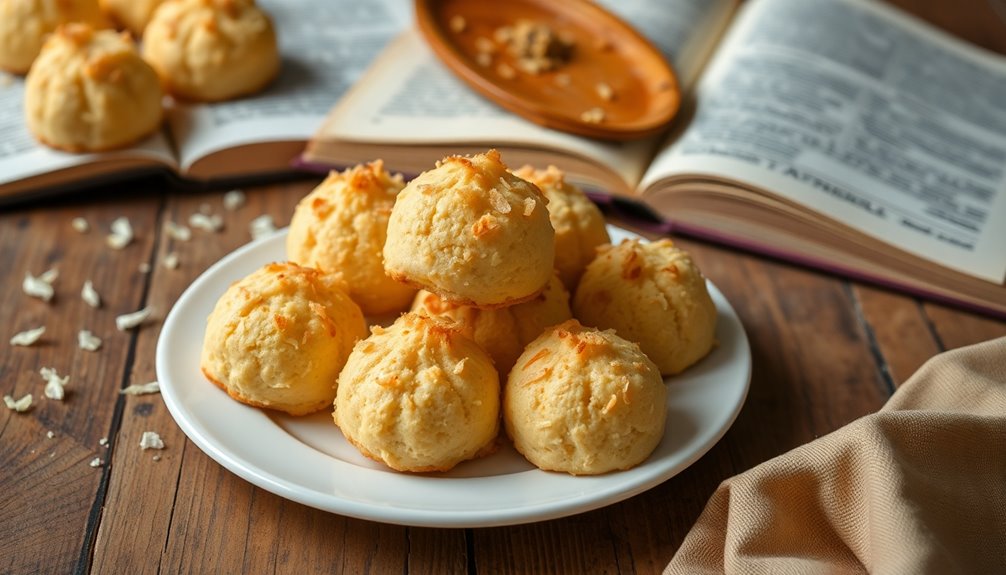
When you take a bite of a coconut macaroon, you mightn't realize that this delightful treat has a rich history that stretches back centuries. These chewy confections have their cultural origins rooted in the Mediterranean, dating back to the 19th century. The name "macaroon" itself comes from the Italian word "maccarone," which means "to crush," referring to the almonds that were originally used in early recipes.
As you savor each bite, think about how these sweet morsels evolved over time. Initially, coconut macaroons emerged as a variation, made popular by the introduction of shredded coconut in the 19th century. The incorporation of this tropical ingredient not only transformed the macaroon but also connected diverse cultures, especially in the Caribbean, where coconuts are abundant.
Coconut macaroons became a staple in Jewish cuisine during Passover, as they're naturally gluten-free and align with dietary restrictions. This adaptation showcases how recipes can adapt and change, echoing the experiences of those who create them. Through generations, families have passed down their cherished recipes, with each version reflecting personal touches and traditions.
As you enjoy your macaroon, you're partaking in a culinary narrative that spans continents and cultures. By embracing the rich history of coconut macaroons, you're not just indulging in a treat; you're connecting with a community that values shared experiences and the joy of good food.
Essential Ingredients
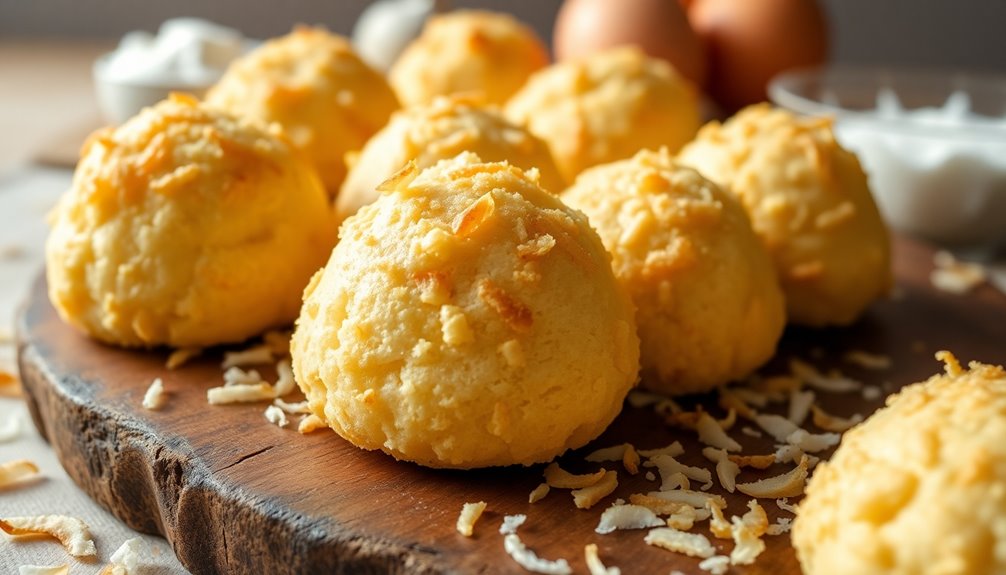
To craft the ideal coconut macaroon, you'll need a handful of key ingredients that combine to create that delightful chewy texture and irresistible sweetness. Each element plays a vital role in achieving that classic flavor you desire, so let's delve into what you'll require.
First and foremost, the star of the recipe is the coconut. You can choose from various coconut varieties, such as sweetened shredded coconut for extra flavor or unsweetened for a more understated taste. The decision you make will affect the overall sweetness of your macaroons.
Next, you'll need egg whites, which act as the binding component. They assist in forming that delightful chewy texture that makes each bite enjoyable. Sugar is another essential element, providing balance and enhancing the sweetness of your treats.
Lastly, a touch of vanilla extract enhances the flavor profile, giving your macaroons a lovely scent that will waft through your kitchen.
Here's a brief rundown of the key ingredients:
- Coconut varieties (sweetened or unsweetened shredded coconut)
- Egg whites (for binding)
- Granulated sugar (for sweetness)
Understanding these key ingredients and how they collaborate is the initial step in mastering the baking methods necessary to create your own coconut macaroons. With these components ready, you're on the right track to making a dessert that's ideal for sharing with loved ones, uniting everyone in the joy of baking.
Classic Coconut Macaroon Recipe
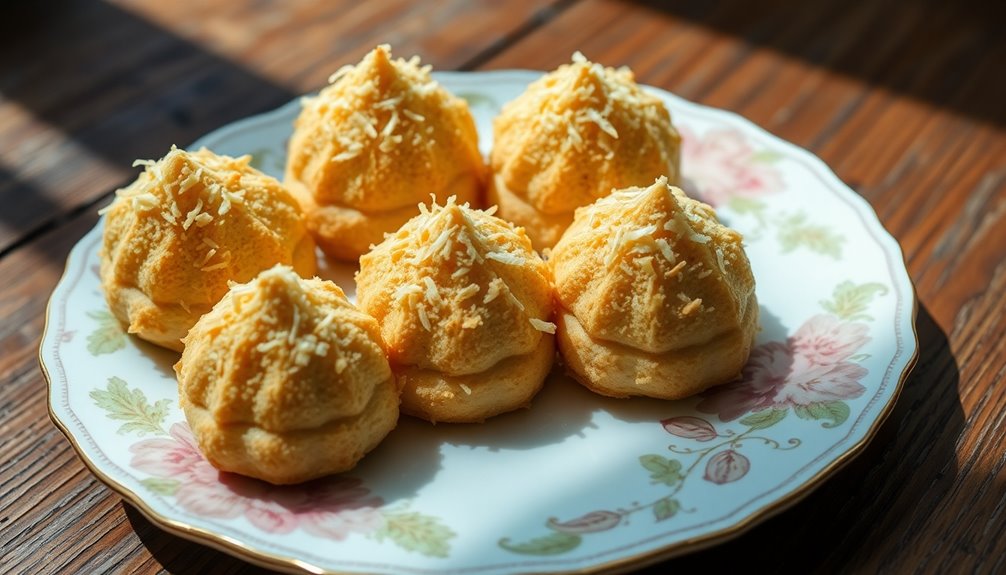
Creating traditional coconut macaroons is a delightful experience that brings the warm, tropical flavors of coconut right into your kitchen. To get started, gather your necessary ingredients: sweetened shredded coconut, condensed milk, vanilla extract, and egg whites. You'll be amazed at how simple it's to whip up these delicious treats!
First, preheat your oven to 325°F (165°C) and line a baking sheet with parchment paper. This guarantees your macaroons won't stick and helps maintain their perfect coconut texture.
In a large bowl, combine the shredded coconut, condensed milk, and vanilla extract. The sticky mixture will hold everything together, creating that unmistakable chewiness we love.
In a separate bowl, beat the egg whites until they form soft peaks. This step is essential—you want that light, airy quality. Gently fold the whipped egg whites into the coconut mixture, being careful not to deflate them. This is one of those vital baking techniques that'll elevate your macaroons!
Using a spoon or cookie scoop, drop mounds of the mixture onto your prepared baking sheet. Bake for about 15-20 minutes, or until the tops are golden brown. The aroma will fill your home, inviting everyone to join in the fun.
Once they're done, let the macaroons cool on the sheet before transferring them to a wire rack.
Sharing these traditional coconut macaroons with friends and family will surely create cherished memories and a sense of belonging. Enjoy every delightful bite!
Tips for Perfecting Macaroons
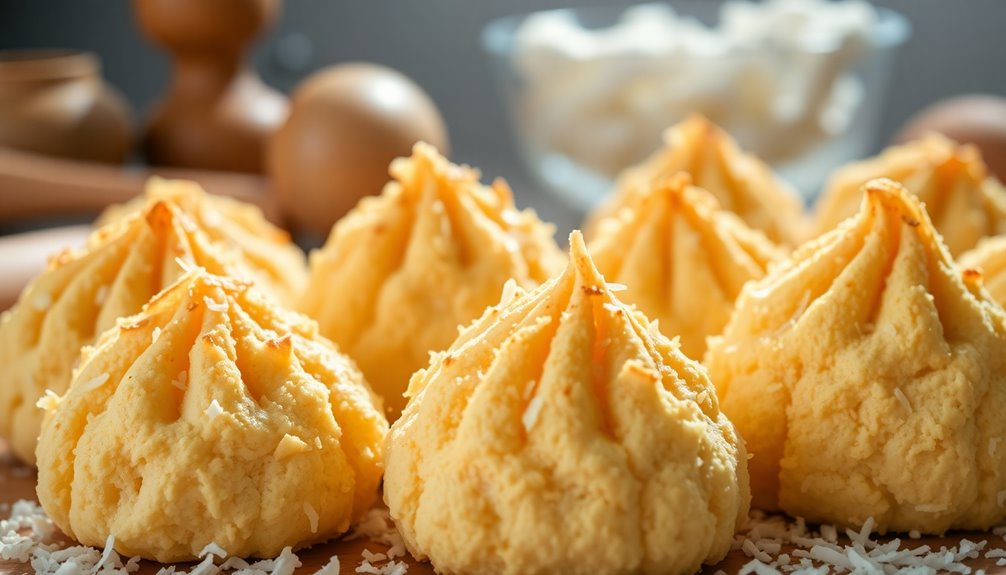
Perfecting coconut macaroons can enhance your baking game, and there are a few key tips to keep in mind. You want your macaroons to be chewy on the inside with a golden-brown exterior—achieving that ideal coconut texture requires attention to detail and some essential baking techniques.
First, consider the coconut you use. Opt for sweetened shredded coconut for that delightful chewiness, and be certain to let it sit at room temperature for a bit before mixing. This helps enhance its flavor and texture.
Next, pay attention to your egg whites. For the best results, use room temperature egg whites, as they whip up more easily and create a lighter, airy consistency. You'll want to whisk them until they form stiff peaks, which adds volume to your macaroons.
Finally, don't rush the baking process. Here are three key baking techniques to follow:
- Chill the dough: Let your macaroon mixture rest in the fridge for at least 30 minutes before baking. This helps them hold their shape.
- Use a cookie scoop: This guarantees uniformity in size, so they bake evenly.
- Bake in batches: If your oven is crowded, it can lead to uneven baking. Give your macaroons room to rise and spread.
With these tips in mind, you'll be well on your way to perfecting those irresistible coconut macaroons that everyone will love!
Flavor Variations to Try
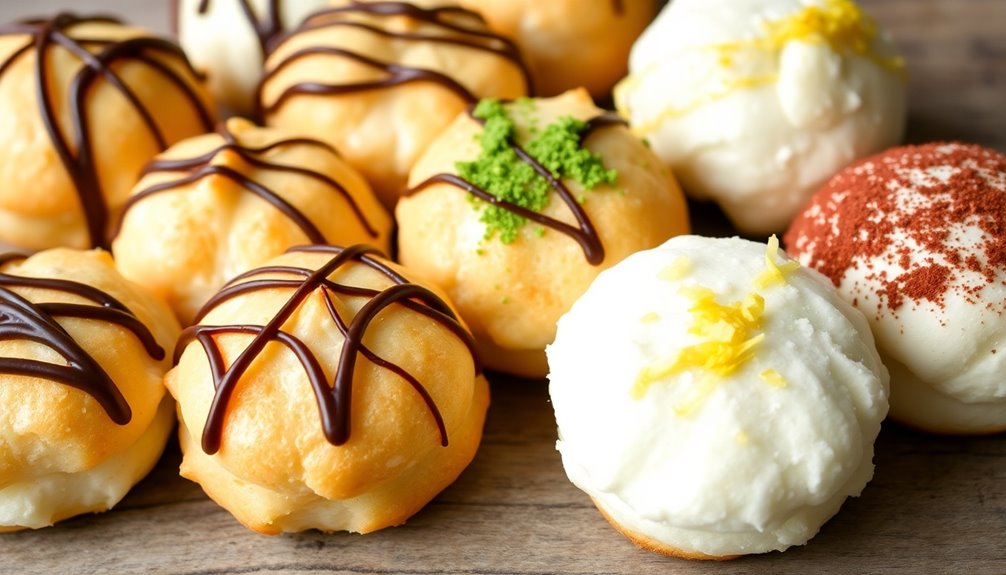
While coconut macaroons are delightful on their own, experimenting with different flavors can elevate them to a whole new level. Why not whisk your taste buds away on a global adventure? You can create unique combinations that incorporate international influences, making your macaroons truly unforgettable.
Start by adding a splash of almond extract for a touch of Marzipan magic, reminiscent of sweet European pastries.
If you're feeling adventurous, toss in some matcha powder to infuse a vibrant green hue and a hint of earthy flavor, reflecting the traditions of Japanese confections.
For a tropical twist, mix in crushed pineapple or mango puree, giving your treats a invigorating, sun-soaked taste.
Chocolate lovers will rejoice at the thought of incorporating cocoa powder or melted dark chocolate into the mixture. You can also dip half of each macaroon in chocolate for that perfect sweet and salty balance.
If you're a fan of spices, try adding a sprinkle of cinnamon or a dash of cardamom to evoke the warmth of Middle Eastern desserts.
Don't forget the toppings! Rolling your macaroons in crushed nuts or drizzling them with flavored syrups can further enhance their appeal. Each variation you try not only brings new flavors but also fosters a sense of community as you share these delights with friends and family.
Coconut Macaroons vs. Macarons
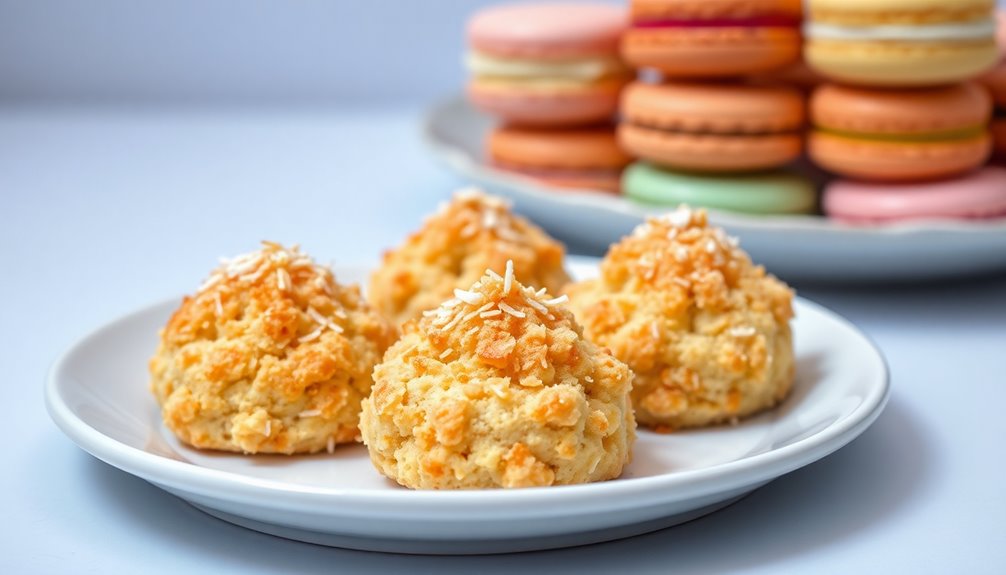
Distinguishing between coconut macaroons and macarons can be a delightful yet confusing journey for dessert lovers. While both are beloved treats, they're quite different in ingredients, textures, and baking techniques. Coconut macaroons are a chewy, coconut-rich delight, while macarons are delicate almond meringue cookies filled with luscious ganache or buttercream.
Here's what sets them apart:
- Ingredients: Macaroons typically consist of shredded coconut, egg whites, and sugar, while macarons are made from almond flour, egg whites, and powdered sugar.
- Texture: Biting into a macaroon reveals a moist, chewy interior with a crisp exterior. In contrast, macarons boast a light, airy texture with a signature smooth shell.
- Baking Techniques: Macaroons require minimal technique—you'll mix and bake! Macarons, on the other hand, demand precision and patience, often involving specific folding methods and temperature controls.
Both coconut desserts have their own charm, but if you're craving a quick, satisfying sweetness, coconut macaroons are your go-to. For a more sophisticated treat, macarons offer a delightful experience, perfect for special occasions or impressing guests.
In the end, whether you choose a coconut macaroon or a macaron, you're indulging in a world of flavors and experiences. Each bite connects you to a community of dessert enthusiasts who appreciate the art of baking and the joy of sharing delicious moments. So, which one will you try first?
Storing and Freezing Tips
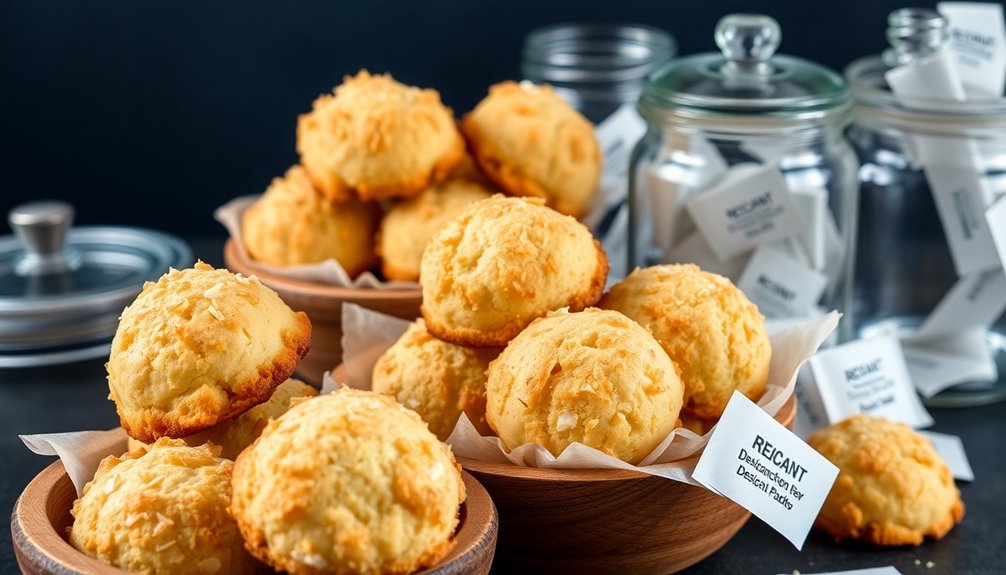
Coconut macaroons are a delightful treat that deserves proper care to maintain their chewy texture and rich flavor. To guarantee you can enjoy these delicious morsels for days, or even weeks, mastering the art of storing and freezing is essential.
For short-term storage, keep your macaroons in an airtight container at room temperature for up to a week. This will help preserve their moisture and prevent them from drying out.
If you find yourself with a larger batch or simply want to save some for later, consider long-term storage options.
When it comes to freezing techniques, you'll want to make certain your macaroons are completely cooled before packing them away. Lay them out on a baking sheet lined with parchment paper, leaving space between each macaroon. Freeze them for about two hours until they're firm. Then, transfer the frozen treats into a freezer-safe bag or container, removing as much air as possible. This method not only saves space but also shields them from freezer burn.
When you're ready to indulge again, simply take out the desired amount and let them thaw at room temperature. You'll be amazed at how well they retain their delightful texture and flavor, almost as if they were just made.
With these storing and freezing tips, you'll always have a sweet treat on hand to share with friends and family, creating moments of joy and togetherness.
Serving Suggestions
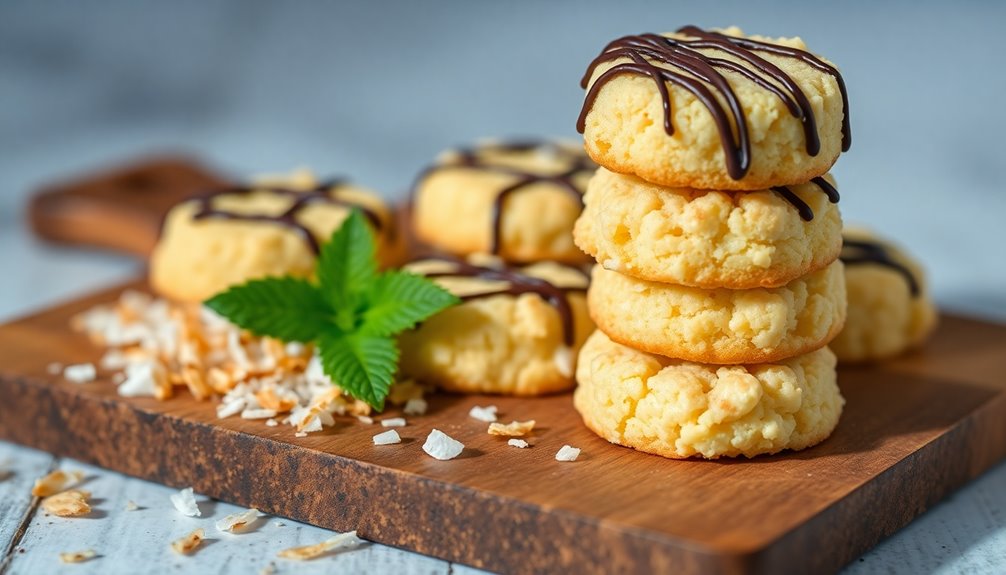
After you've successfully stored or frozen your coconut macaroons, it's time to think about how to serve them for maximum enjoyment. The beauty of these delightful treats lies not just in their taste but also in how you present them. You can elevate the experience with some creative presentations that will impress your friends and family.
Consider these serving ideas to make your coconut macaroons sparkle:
- Elegant Platters: Arrange your macaroons on a beautiful serving platter, perhaps with a sprinkle of shredded coconut or drizzled chocolate for an enticing visual effect.
- Individual Treat Bags: Package them in clear bags tied with a ribbon for a personal touch. This is perfect for parties or as thoughtful gifts.
- Dessert Bar: Create a dessert bar featuring your macaroons alongside other treats like fresh fruits, whipped cream, or chocolate sauce for dipping.
Pairing options also play an essential role in enhancing the enjoyment of your macaroons. Consider complementing their sweetness by serving them with:
- A rich cup of coffee or espresso to balance the flavors.
- A invigorating tropical smoothie to bring out the coconut's natural essence.
- A scoop of vanilla ice cream, creating a delightful contrast in texture.
With these ideas, you're not just serving coconut macaroons; you're crafting an experience that encourages connection and creates lasting memories. So go ahead, let your creativity shine, and enjoy every bite!
Healthier Alternatives
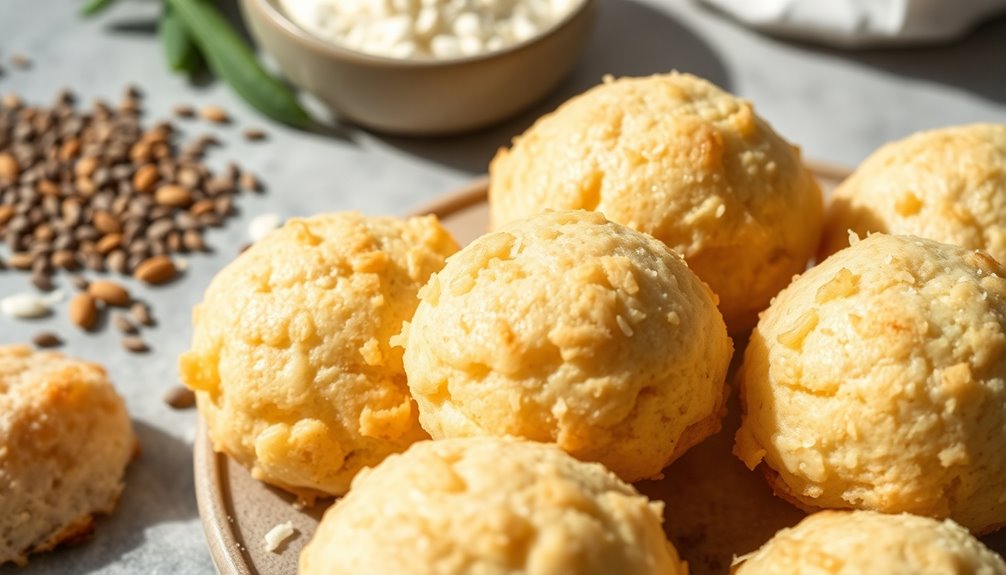
When you're craving a sweet treat but want to keep things on the healthier side, there are plenty of delicious alternatives to traditional coconut macaroons. You can whip up a batch of low sugar macaroons that satisfy your sweet tooth without the guilt. By using natural sweeteners like stevia or monk fruit, you'll enjoy the same delightful flavor while keeping your sugar intake in check.
Another fantastic option is to make gluten-free coconut macaroons. Many recipes can be easily adapted to eliminate gluten, using almond flour or simply sticking with shredded coconut as the base. These ingredients not only maintain that chewy texture you love but also guarantee that everyone can indulge, regardless of dietary restrictions.
You might also explore adding ingredients like dark chocolate or nuts to your healthier macaroons. A drizzle of dark chocolate provides that rich sweetness while boasting health benefits, including antioxidants. Plus, adding chopped nuts gives your treat an extra crunch and boosts the nutritional value.
Frequently Asked Questions
Can I Use Dried Coconut Instead of Fresh Coconut?
Absolutely, you can use dried coconut instead of fresh coconut in your baking! Just keep in mind that dried coconut has a different texture, which may affect the final product.
For baking substitutions, rehydrate the dried coconut in warm water to mimic the moisture of fresh coconut. This way, you maintain a delightful consistency in your dish.
Embrace the change, and your baked goods will still turn out delicious and satisfying!
Are Coconut Macaroons Gluten-Free?
Yes, coconut macaroons are typically gluten-free! When you make them, you're using simple ingredients like shredded coconut, egg whites, and sugar, which don't contain gluten. If you're considering ingredient substitutions due to dietary restrictions, just make sure any added ingredients are also gluten-free.
This delightful treat can fit into your gluten-free lifestyle, allowing you to indulge without worry. Enjoy sharing these sweet bites with friends who appreciate a good, gluten-free dessert!
How Long Do Macaroons Take to Bake?
Did you know that most macaroons take about 15 to 20 minutes to bake? This short baking time is essential for achieving that perfect texture. You want them crispy on the outside while remaining chewy inside.
Using fresh coconut can enhance the taste, giving a delightful contrast to dried coconut. Keep an eye on them, and you'll be rewarded with delicious bites that everyone will enjoy, bringing a sense of community to your kitchen.
Can I Freeze Baked Coconut Macaroons?
Absolutely, you can freeze baked macaroons! For storage options, let them cool completely, then place them in an airtight container or freezer bag.
The freezing process is simple: just layer parchment paper between each macaroon to prevent sticking.
When you're ready to enjoy them, thaw them in the fridge for a few hours. This way, you'll always have a delicious treat ready to share with friends or family whenever you want!
What Is the Best Way to Serve Coconut Macaroons?
When serving your treats, think about creative toppings to elevate their appeal. Drizzling melted chocolate or sprinkling crushed nuts adds a delicious twist.
For presentation ideas, arrange them on a vibrant platter or use elegant cupcake liners to create an inviting display.
You might also consider serving them alongside fresh fruit or a scoop of ice cream for a delightful contrast. These little touches will make everyone feel welcome and keen to indulge!
Conclusion
In the sweet symphony of desserts, coconut macaroons stand out as delightful notes of tropical bliss. With their golden, toasted exteriors and chewy interiors, these treats invite you to savor each bite. Whether you stick to the classic recipe or venture into exciting flavor variations, you're bound to captivate your taste buds. So, gather your ingredients, awaken your creativity, and let these delectable morsels whisk you away to a sun-kissed paradise with every indulgent nibble.

